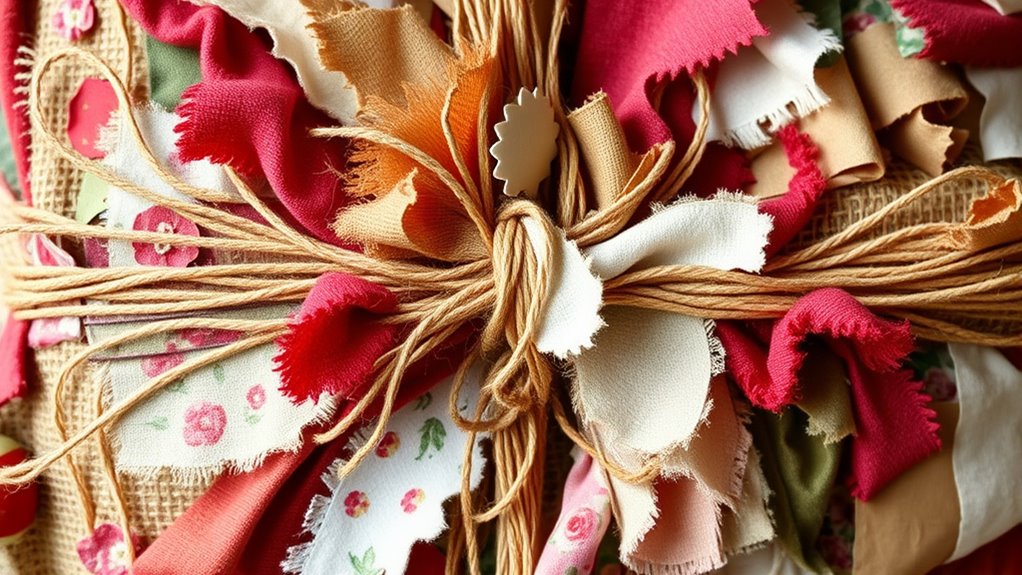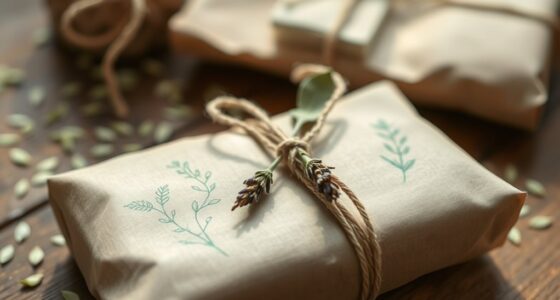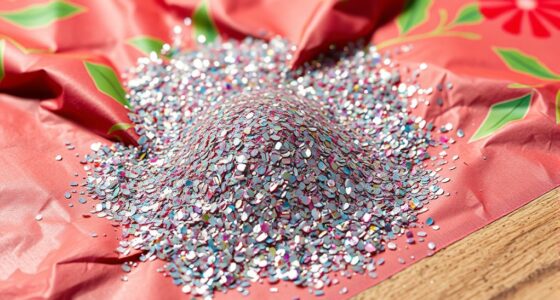Reusing fabric scraps for wrapping is a fantastic way to make your gifts eco-friendly and unique. You can experiment with different textures, colors, and folding techniques like origami or creative knots to create beautiful, personalized wraps. Add charming embellishments or craft reusable fabric bags from your scraps for even more sustainability. If you explore sustainable wrapping ideas further, you’ll discover plenty of inspiring ways to give your gifts a thoughtful, stylish touch while reducing waste.
Key Takeaways
- Transform fabric scraps into reusable wrapping bags using durable materials like canvas or denim to minimize waste.
- Create decorative embellishments such as fabric flowers, bows, or knots from scraps to personalize and enhance the presentation.
- Practice artistic folding techniques, like origami, to craft unique, eco-friendly wraps that reduce the need for additional materials.
- Incorporate regional or cultural motifs into fabric wraps for meaningful, sustainable packaging that celebrates local traditions.
- Use natural dyes from plants to add vibrant, eco-conscious color accents, enhancing the aesthetic while maintaining sustainability.
Choosing the Right Fabric Scraps for Wrapping
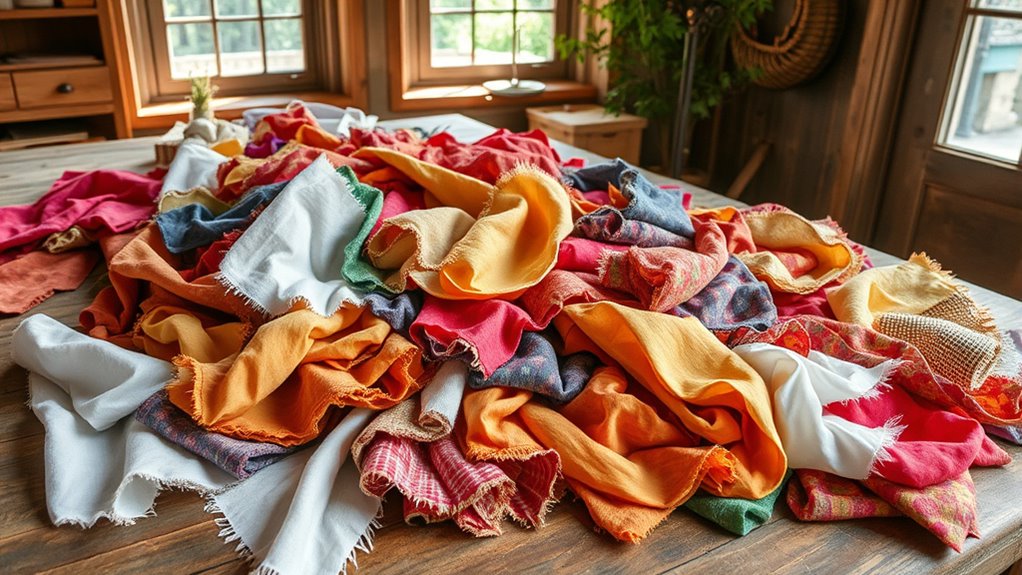
When selecting fabric scraps for wrapping, it’s important to contemplate both the texture and durability of the material. You want fabric texture that feels pleasant and suits the occasion, whether smooth silk or rustic burlap. Consider how the fabric’s surface will interact with the item and your tying techniques. Durability matters too; sturdy fabrics like denim or canvas hold up well and can be reused multiple times. Additionally, pay attention to color harmony—choose scraps whose hues complement each other or the gift’s box. This creates an elegant, cohesive look. Avoid overly delicate fabrics that might tear easily, and aim for textures and shades that enhance your overall presentation. Using reusable fabric scraps not only reduces waste but also adds a personalized touch to your gift wrapping. Selecting fabrics with appropriate texture and strength ensures your wrapping remains both sustainable and visually appealing. Incorporating fabrics with versatile qualities can further enhance the durability and aesthetic appeal of your wrapping, making your presentation both eco-friendly and attractive. Thoughtful selection guarantees your wrapping is both sustainable and visually appealing.
Creative Folding and Tying Techniques

You can transform simple fabric scraps into eye-catching wraps by exploring artistic folding patterns that add flair to your presentation. Experiment with unique knot styles to secure your wrapping creatively and sustainably. Brighten up your package with colorful layering techniques that make your gift stand out while reducing waste. Incorporating color accuracy such as precise color matching and calibration can also enhance the overall visual appeal of your wrapping. Additionally, implementing cybersecurity best practices such as secure handling of digital payment methods can also enhance the overall safety of your gift-giving process. Embracing self-reflection can help you develop more personalized and meaningful wrapping styles that resonate with your creative goals.
Artistic Folding Patterns
Have you ever wondered how intricate folding patterns can transform simple wrapping into a work of art? Artistic folding patterns elevate your wrapping, turning fabric scraps into eye-catching displays. You can explore folding origami techniques, which allow you to create detailed shapes and figures. Incorporate geometric patterns to add symmetry and visual interest, making each package unique. Here are some ideas to get started:
- Use crisp folds to form flower-like shapes.
- Combine creases to create layered, dimensional effects.
- Experiment with symmetry for striking geometric designs.
- Practice precise folding origami to craft complex figures effortlessly. Developing a visual vocabulary of folding techniques can help expand your creative options and improve your craftsmanship. Understanding family influences can also inspire unique design ideas that reflect personal heritage and cultural motifs.
A strong understanding of minimalist design principles can help guide your creative choices and ensure your wrapping remains elegant and uncluttered.
Mastering these patterns enhances your wrapping skills and adds an artistic touch to sustainable packaging. With a little practice, your fabric scraps become versatile canvases for creative expression.
Unique Knot Styles
Building on artistic folding patterns, exploring unique knot styles offers a creative way to elevate your sustainable wrapping. Fabric knot tutorials can guide you in crafting eye-catching ties that add personality to your wrapped gifts. Experiment with different knot techniques, such as the sailor knot or double knot, to create distinctive looks. Incorporate unique bow styles by tying fabric scraps in new ways, transforming simple wraps into artistic statements. These knots not only secure your wrapping but also serve as decorative focal points. Practice makes perfect, so don’t hesitate to try various styles until you find what best complements your fabric and occasion. Additionally, understanding cultural beliefs surrounding traditional knot styles can inspire more meaningful and aesthetically pleasing designs. Recognizing the versatility of fabric scraps can help you repurpose even small pieces into beautiful decorative knots, reducing waste and enhancing your craft. Exploring natural fibers can also influence the durability and appearance of your knots, making your wrapping even more eco-friendly. With creative folding and innovative knotting, you bring a personal touch to eco-friendly wrapping that’s both functional and stylish.
Colorful Layering Techniques
Colorful layering techniques breathe new life into sustainable wrapping by combining different fabrics, colors, and textures to create eye-catching displays. You can experiment with textile dyeing to add vibrant hues and depth to your layers. Play with fabric textures—smooth silk, rough burlap, or soft cotton—to create visual interest. Incorporating eco-friendly materials into your layers enhances both sustainability and aesthetic appeal. Creative folding and tying techniques help showcase these layers uniquely. Incorporating affiliate links to quality fabrics can inspire new ideas and ensure sustainable choices. Exploring Kia Tuning options can also inspire creative customization techniques, adding a personalized touch to your wrapping projects. These techniques make your wrapping lively and personalized, emphasizing the beauty of reusing fabric scraps sustainably.
Incorporating Embellishments and Personal Touches

Adding embellishments and personal touches to your sustainable wrapping not only enhances its visual appeal but also makes the gift feel more meaningful. Use simple embellishment techniques like adding buttons, fabric flowers, or embroidered details to give your wrapping a unique flair. Personal touches, such as handwritten tags, small charms, or a heartfelt note sewn into the fabric, further personalize the presentation. These details show thoughtfulness and creativity, transforming a basic wrap into a memorable experience. Keep in mind that subtle accents often stand out more than overly elaborate decorations. By carefully selecting embellishments and personal touches, you create an eco-friendly wrapping that’s both beautiful and heartfelt, emphasizing your commitment to sustainability while adding a special, personal element to every gift. Incorporating skincare tips can also inspire creative ways to decorate with natural or eco-friendly materials, enhancing your gift presentation even further. For example, using gentle, natural dyes made from plants can add a unique, eco-conscious touch to your embellishments.
Making Reusable Fabric Bags From Scraps
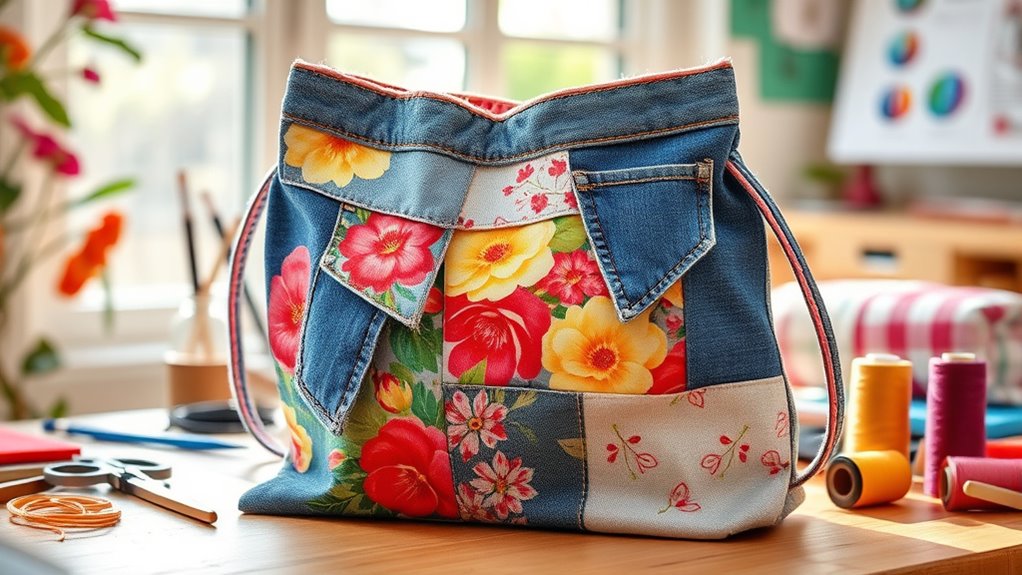
You can transform scraps into sturdy, reusable fabric bags that reduce waste and add a personal touch. Choosing durable fabrics guarantees your bags last through repeated use, while proper sewing and finishing techniques keep them strong and attractive. With some basic tips, you’ll create functional, eco-friendly bags from materials you already have. Incorporating regional flavors and traditions into your designs can make your bags uniquely representative of local culture and culinary arts. Additionally, selecting fabrics that are resistant to wear and tear, such as recycled materials, ensures your bags remain functional over time. Understanding sustainable practices can further enhance the eco-friendliness of your projects.
Selecting Durable Fabrics
Choosing the right fabrics is essential for creating durable, reusable bags from scraps. To guarantee your bags last, focus on fabrics with high fabric durability and textile longevity. Here are some tips:
- Opt for tightly woven fabrics like canvas or denim, which resist tearing and wear.
- Choose natural fibers such as cotton or hemp, known for their strength and durability.
- Avoid lightweight or loosely woven materials that may fray or rip easily.
- Test fabric thickness and resilience to ensure it holds up after multiple uses.
Sewing and Finishing Tips
Once you’ve selected sturdy fabrics, the next step is sewing with precision to guarantee your reusable bags are both strong and professional-looking. To achieve this, focus on fabric stabilization to prevent stretching or puckering. Use interfacing or stay tape when needed to reinforce weak spots. Finish your seams properly with seam finishing techniques like zigzag stitching or serging, ensuring durability and a clean look. Take your time aligning edges and sewing slowly to maintain neatness. Proper seam finishing not only enhances appearance but also prolongs the bag’s lifespan. Incorporating spiritual practices such as mindful sewing can deepen your connection to your craft and promote a sense of purpose in your sustainable efforts. Developing creative practice through repetitive techniques can help refine your skills and inspire new ideas. Understanding the importance of Gold IRA regulations can help you make informed decisions when investing in precious metals for your future security.
Eco-Friendly Dyeing and Color Coordination
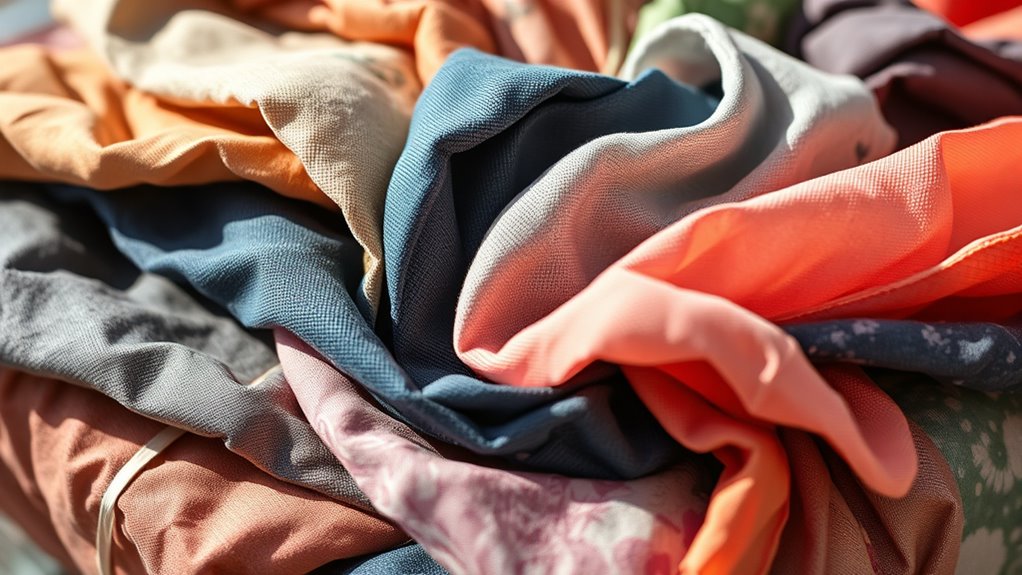
Eco-friendly dyeing methods are transforming the way you add color to packaging materials by reducing environmental impact and minimizing harmful chemicals. Natural dyeing uses plant-based pigments, making your wrapping eco-conscious and vibrant. To achieve beautiful color harmony, consider these tips:
- Select complementary shades from natural sources for a cohesive look.
- Experiment with layering dyes to create unique, nuanced hues.
- Test color combinations beforehand to ensure harmony and avoid clashes.
- Use subtle color accents to highlight specific fabric scraps effectively.
- Incorporate genetic variation in dog coat colors to explore diverse natural shades and enrich your dyeing palette.
Upcycling Fabric Scraps Into Decorative Elements
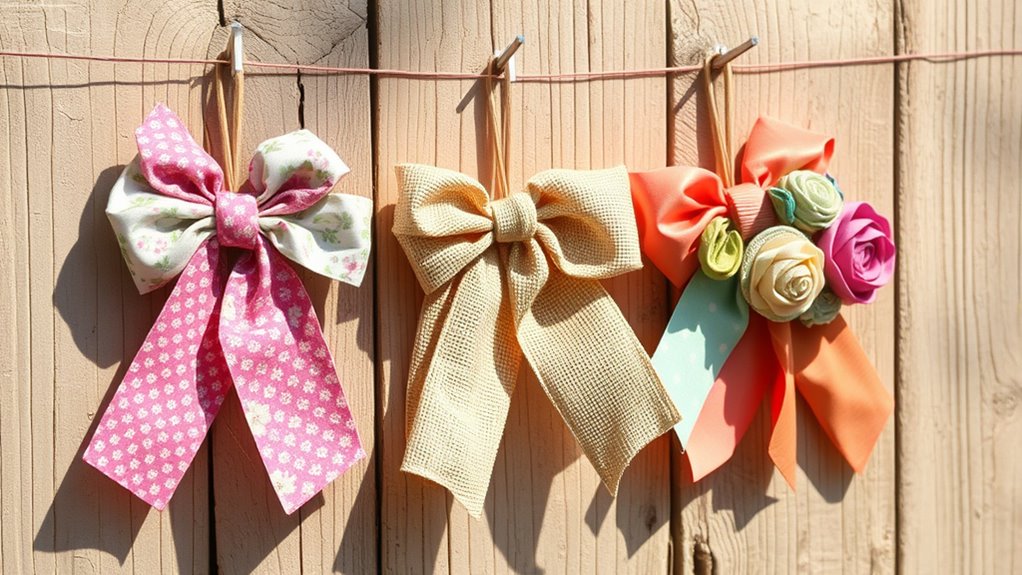
Transforming fabric scraps into decorative elements is an effective way to add a personalized touch to your sustainable packaging. You can create charming embellishments by combining scraps with different fabric textures, adding visual interest and tactile appeal. Focus on color harmony to guarantee your decorations complement your wrapping; choose scraps with shades that coordinate or contrast intentionally. For example, pairing soft, textured linen with smooth cotton in similar hues creates a balanced look. Use small fabric pieces to make bows, rosettes, or fabric flowers, which can be sewn or glued onto your package. This approach not only reduces waste but also showcases your creativity. By thoughtfully upcycling fabric scraps into decorative accents, your packaging becomes uniquely stylish and eco-friendly.
Tips for Maintaining and Storing Your Wrapping Pieces
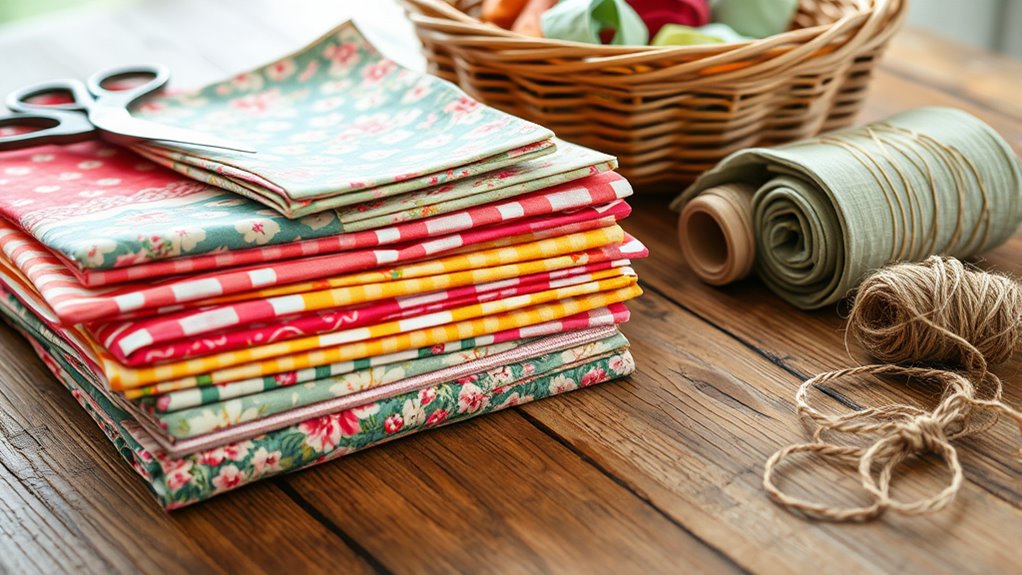
To keep your wrapping pieces in top condition, regular maintenance and proper storage are essential. Proper fabric care prevents fading, stretching, or damage over time. To guarantee longevity, follow these tips:
Regular maintenance and proper storage keep your wrapping fabric vibrant and durable over time.
- Store fabric scraps in breathable containers like cotton bags to prevent moisture buildup.
- Fold fabric neatly to avoid wrinkles and creases that can weaken fibers.
- Keep your fabric scraps away from direct sunlight, which can fade colors.
- Regularly check stored pieces for pests or mold, especially in humid environments.
Using effective storage solutions helps preserve your fabric scraps’ quality and appearance. Keep in mind that gentle fabric care and organized storage will make your wrapping pieces easier to access and reuse, ensuring they stay vibrant and functional for future projects.
Inspiring DIY Projects for Special Occasions
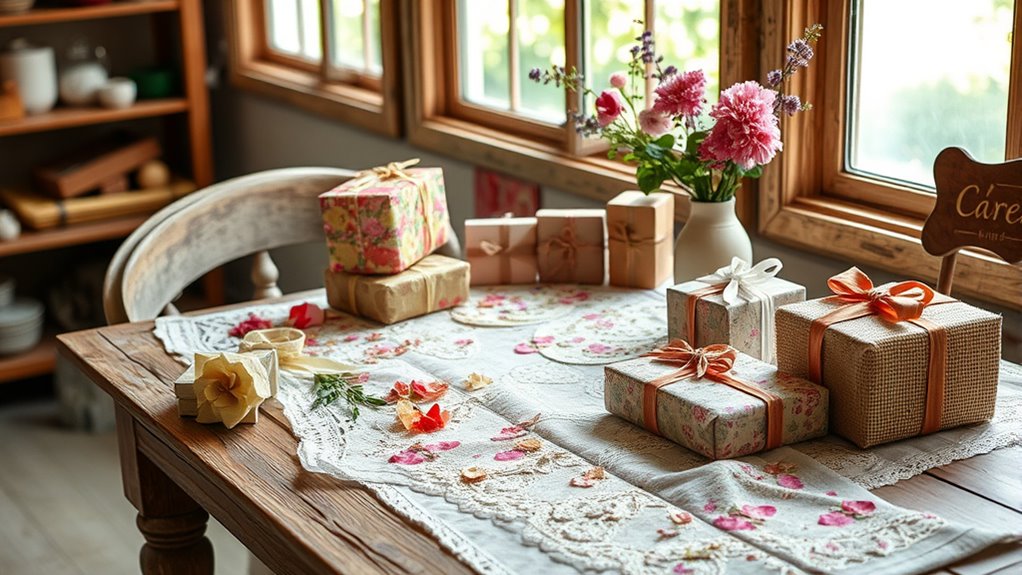
Special occasions call for personalized touches, and DIY wrapping projects are a perfect way to add a unique flair to your gifts. Using fabric scraps with varied fabric textures creates interesting tactile experiences, making your wrapping stand out. Focus on color harmony by choosing scraps that complement each other or match the theme of the event. For example, soft, pastel fabrics work beautifully for baby showers, while rich, jewel tones suit weddings or anniversaries. You can layer textures like lace, burlap, or silk for added visual appeal. Wrap your gift neatly, and consider adding handcrafted embellishments from leftover scraps. These thoughtful details not only showcase creativity but also reinforce your commitment to sustainability, making your special occasions even more meaningful.
Sharing and Spreading Sustainable Wrapping Ideas
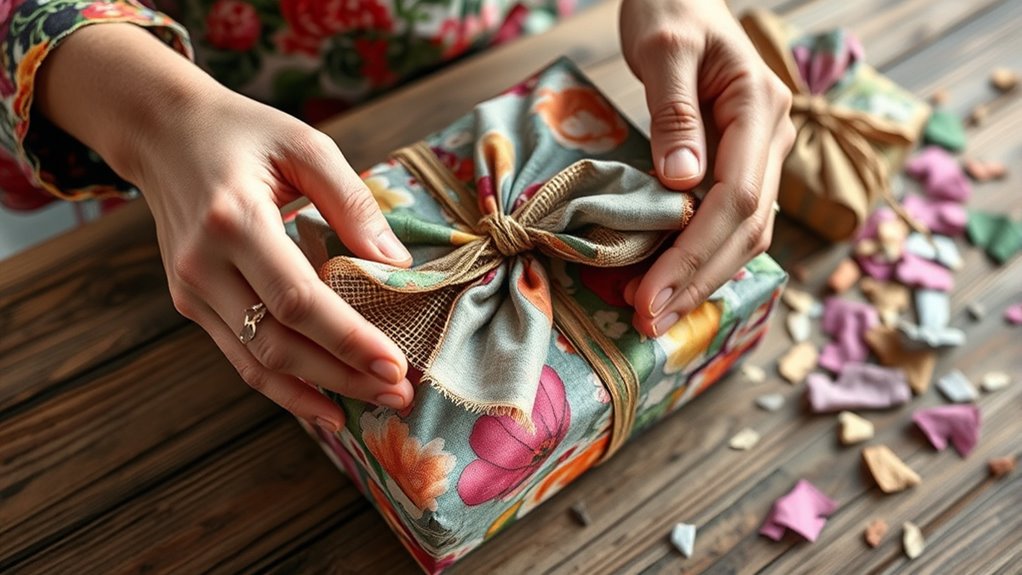
Have you ever wondered how to inspire others to embrace sustainable wrapping? Sharing your ideas can spark a wider movement. Use these strategies to spread sustainable wrapping techniques effectively:
- Demonstrate recycling techniques by hosting small workshops or sharing tutorials online, showing how to reuse fabric scraps creatively.
- Showcase fabric care tips that prolong the life of your reusable wraps, encouraging others to adopt eco-friendly habits.
- Share your projects on social media, using photos and videos to inspire friends and followers.
- Collaborate with local shops or community centers to organize swap events or craft sessions, spreading awareness and practical skills.
Frequently Asked Questions
How Long Can Reusable Fabric Wrapping Last With Proper Care?
With proper care, your reusable fabric wrapping can last several years. Fabric durability depends on the material you choose and how often you wash it. If you wash it gently and avoid harsh detergents, it’ll stay in good shape longer. Limit washing frequency when possible, and store it properly to prevent wear and tear. By taking these steps, your fabric wrapping can remain functional and beautiful for many years.
Are There Eco-Friendly Adhesives Suitable for Fabric Wrapping?
You’re wondering if there are eco-friendly adhesives suitable for fabric wrapping. Yes, there are fabric glue options made from non-toxic, biodegradable ingredients that work well without harming the environment. These eco-friendly adhesives are designed to bond fabric securely while reducing environmental impact. When choosing fabric glue options, look for labels indicating sustainability or natural ingredients, ensuring your wrapping remains eco-conscious and effective.
Can Fabric Scraps Be Used for Gift Tags or Labels?
You can definitely use fabric scraps for gift tags or labels, adding a personal and eco-friendly touch to your presents. Cut small pieces of fabric to write on or attach with eco-friendly adhesives for a charming look. Store your scraps properly for easy access, and consider cultural traditions that incorporate fabric into gift wrapping. This creative reuse reduces waste and adds a meaningful, sustainable element to your gift-giving.
What Are the Best Storage Solutions to Prevent Fabric Deterioration?
Think of your fabric scraps as delicate treasures that need gentle guardians. To prevent fabric deterioration, choose breathable storage containers like cotton bags or archival boxes that allow air to circulate. Keep them in a cool, dark place away from moisture and sunlight, ensuring fabric preservation. Proper storage not only shields your scraps from fading and mold but also keeps them ready for creative reuse whenever inspiration strikes.
How Can Fabric Wrapping Be Adapted for Different Cultural Gift-Giving Traditions?
When adapting fabric wrapping for different cultural traditions, you can incorporate cultural symbolism and traditional techniques. You might choose fabrics with meaningful patterns or colors, respecting local customs. Use traditional wrapping methods, like Japanese furoshiki or Indian sari draping, to honor cultural practices. This approach shows respect and enhances the gift’s significance, blending creativity with cultural sensitivity. Your thoughtful adaptation makes gift-giving more meaningful and culturally appropriate.
Conclusion
So there you have it—your ultimate guide to turning pesky fabric scraps into stylish, eco-friendly wrapping wonders. Who knew that saving the planet could look so good and be so much fun? Now, go ahead, get creative, and impress everyone with your sustainable flair. After all, if wrapping gifts with fabric scraps isn’t a trend, then what is? Just don’t forget to brag a little—you’ve earned it!
